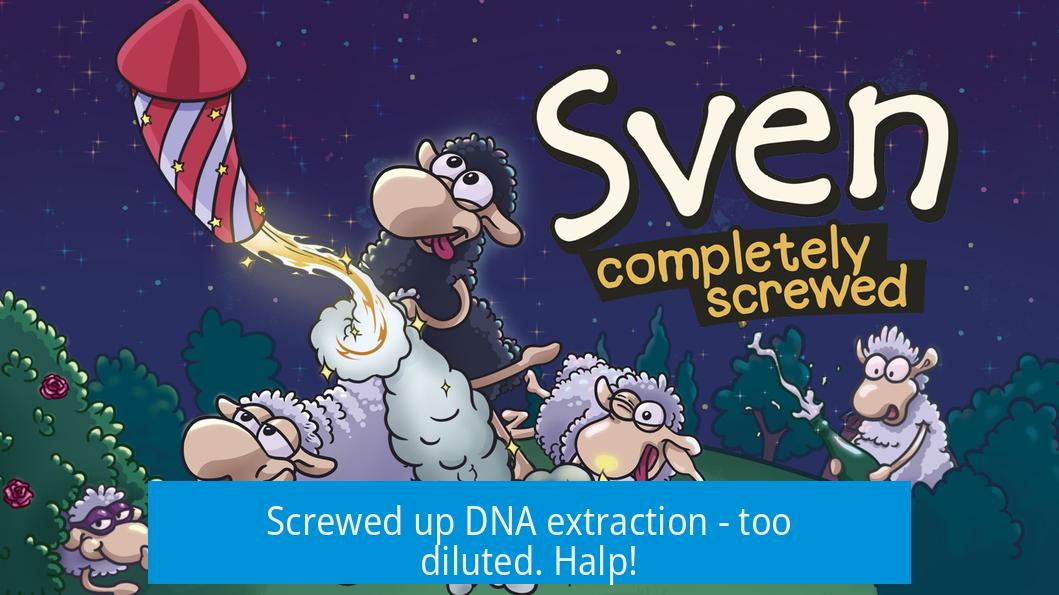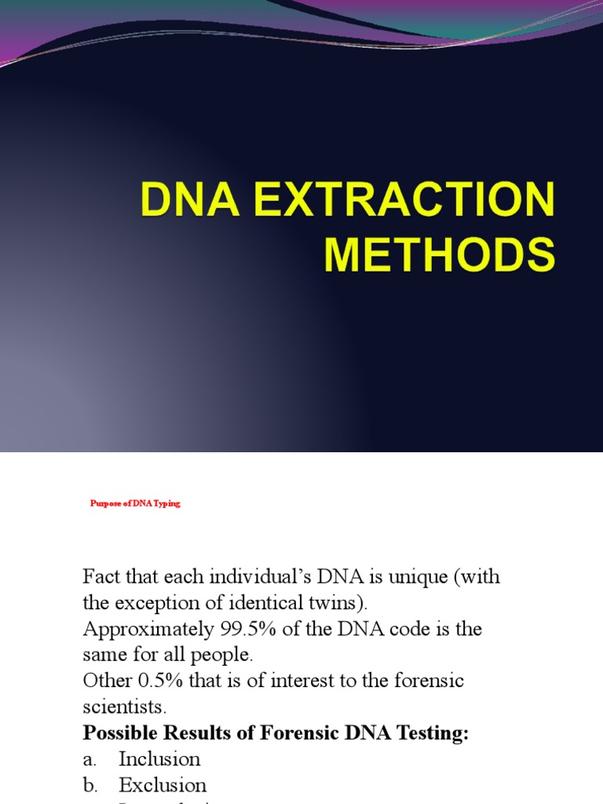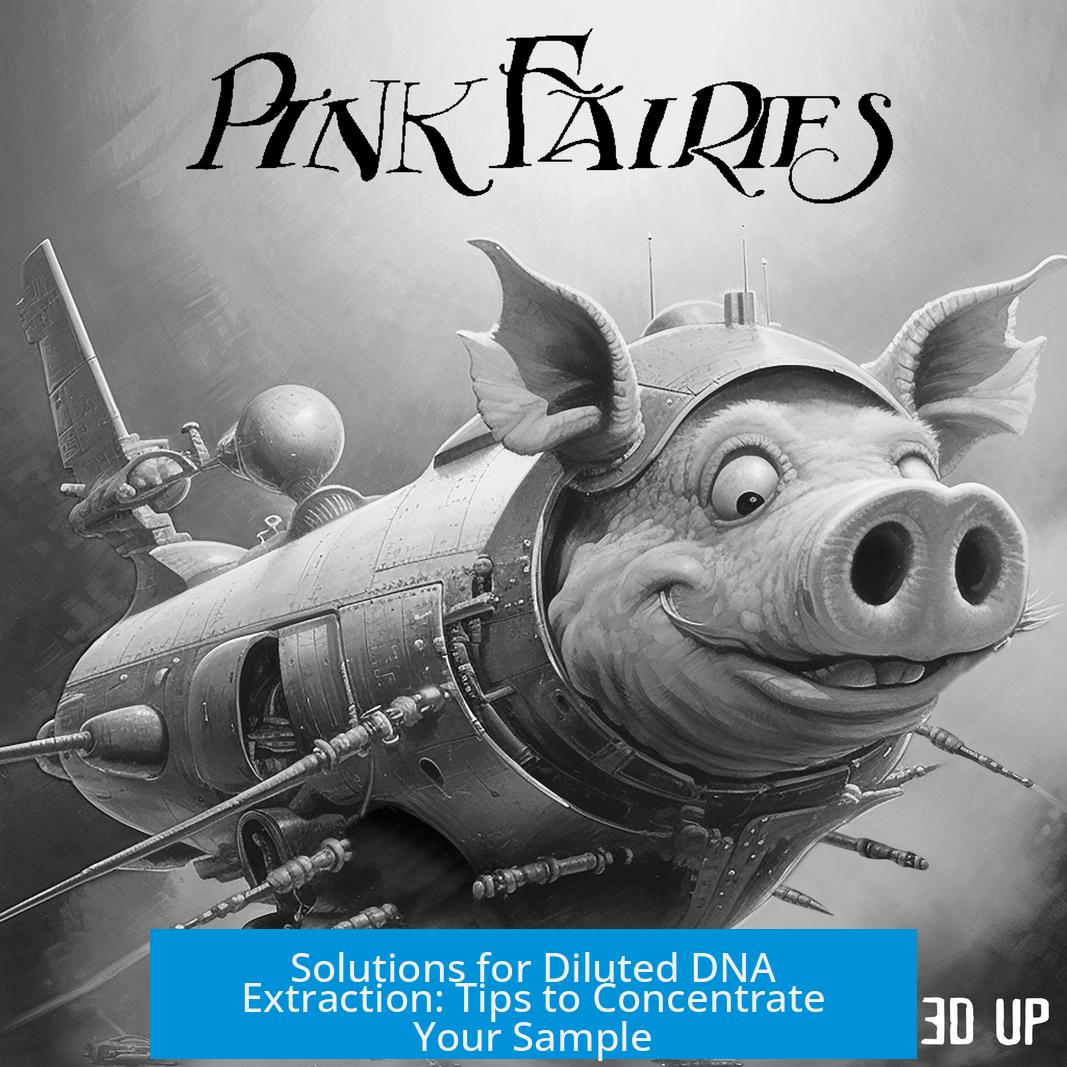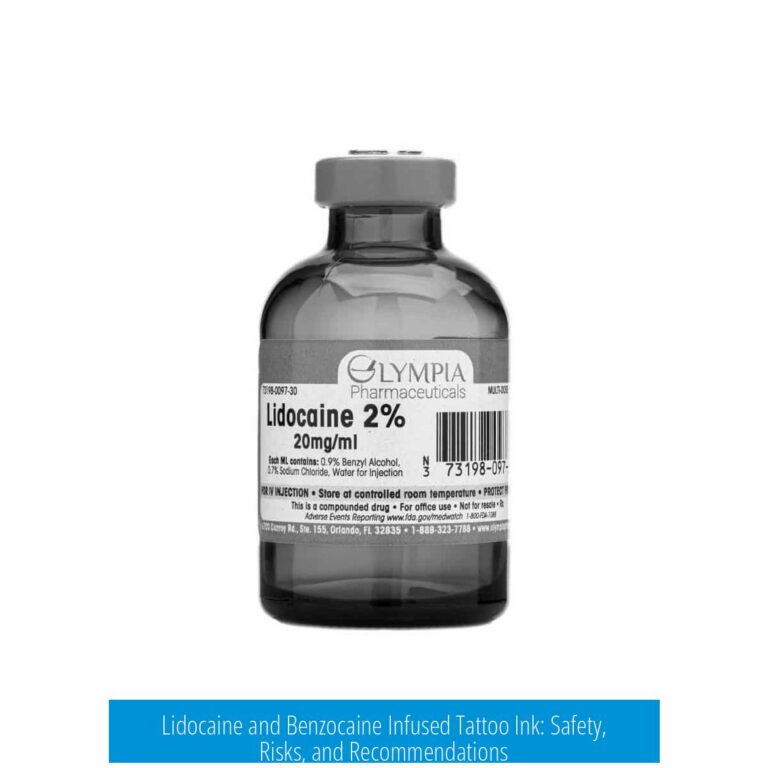Screwed up DNA extraction – too diluted. Halp!

If your DNA sample is too diluted after extraction, the quickest way to concentrate it is ethanol precipitation. This method uses cold ethanol and salts to pellet DNA, allowing you to remove excess liquid and resuspend the DNA in a smaller volume.
Why Does DNA Dilution Matter?

DNA samples that are too diluted can be problematic for downstream applications, such as PCR, sequencing, or cloning. Low DNA concentration reduces reaction efficiency and can cause inaccurate quantification.
Often, after extraction, samples contain large volumes of buffer or water, resulting in concentrations too low for usual protocols.

Methods to Concentrate Diluted DNA
Several practical techniques exist to rescue diluted DNA. Ethanol precipitation is most widely used. Other options include evaporation, centrifugal filters, and re-binding DNA to silica columns.

Ethanol Precipitation to Concentrate DNA
Ethanol precipitation remains a gold standard for DNA concentration. It is simple, effective, and affordable.

Step-By-Step Ethanol Precipitation
- Add 2.5 times the volume of 100% cold ethanol (or isopropanol) to your DNA sample.
- Include 150 mM sodium acetate or sodium chloride to improve DNA precipitation.
- Mix gently and incubate at -20°C overnight or at -80°C for 15 minutes for faster results.
- Centrifuge the tube at maximum speed (e.g., 13,000–15,000 rpm) at 4°C for 30–40 minutes.
- Carefully remove supernatant without disturbing the DNA pellet.
- Optionally wash the pellet with 500 μL of cold 70% ethanol to remove salts.
- Spin briefly again, remove ethanol, and air dry the pellet. Avoid over-drying, which can make DNA hard to dissolve.
- Resuspend the pellet in your desired low volume of TE buffer or nuclease-free water.
Key Tips for Ethanol Precipitation

- Using isopropanol yields a purer pellet but can make it harder to see.
- Sodium acetate (or NaCl) concentration influences yield and purity.
- Do not over-dry the pellet to preserve DNA solubility.
- DNA yields after precipitation range from nanograms to milligrams depending on starting material.
Why this Method Works Well
DNA is insoluble in ethanol when salts are present. Cold temperatures enhance precipitation. Centrifugation forces DNA out of solution as visible pellets. This concentrates DNA effectively by removing liquid volume.
Evaporating Excess Liquid
If ethanol precipitation is not immediately feasible, gently evaporating solvent can concentrate DNA. Using a Speed Vac evaporator speeds this up without DNA loss.
- A Speed Vac removes water under vacuum and mild heat.
- DNA remains stable and concentrated as volume decreases.
- Alternatively, leaving tubes open in a warm incubator overnight allows solvent evaporation but risks contamination.
Considerations for Evaporation
This method is useful for moderate volume reductions but does not remove salts or contaminants. Speed Vac devices require specific equipment and cleaning protocols.
Using Centrifugal Filters
Centrifugal filter devices with low molecular weight cut-offs concentrate DNA mechanically.
- Amicon Ultra filters are popular choices.
- They allow washing and buffer exchange simultaneously.
- Useful when ethanol precipitation is inconvenient.
These devices trap DNA above a certain size while letting smaller molecules and buffers pass through during centrifugation, thereby concentrating your sample.
Rebinding DNA to Silica Columns
If you have DNA-binding silica columns available, you can reconcentrate your diluted DNA by reapplying it to a column.
How It Works
- Mix DNA sample with chaotropic salt buffers to promote DNA binding.
- Pass the mixture through the new silica column.
- Wash salts with ethanol-containing wash buffers.
- Elute the DNA in a smaller volume for higher concentration.
This approach exploits the original binding chemistry of many DNA extraction kits and avoids precipitation or evaporation.
Advantages
- Fast and clean method.
- Allows control of elution volume (e.g., 30-50 μL).
- Useful when maintaining clean DNA is critical.
Additional Tips and Important Notes
Efficient Cell Lysis
For gram-positive bacteria, lysozyme treatment is essential to break tough cell walls before extraction. Poor lysis results in low DNA yield, amplifying dilution problems.
Choosing Between Methods
- For large amounts of plasmid DNA, ethanol precipitation with sodium acetate works well.
- SPRI beads provide high recovery and purity but cost more.
- Sodium acetate + ethanol is cheap, scalable, but sensitivity to technique affects yield.
Handling DNA Pellets
After precipitation, remove supernatant gently. Air dry the pellet but avoid over drying, which reduces solubility. Resuspend in appropriate buffers like TE or nuclease-free water.
Tool to Prevent Dilution Errors
The Lab.Hacks app offers helpful calculations and reminders to avoid mistakes during extractions, including volume planning and reagent mixing. It can be a valuable aid for consistent DNA prep.
Summary of Solutions for Diluted DNA Concentrations
| Method | Key Steps | Advantages | Limitations |
|---|---|---|---|
| Ethanol Precipitation | Add 2.5x 100% EtOH + salts; incubate cold; centrifuge; wash pellet; resuspend | Inexpensive, amplifiable, concentrates large volumes | Time-consuming, requires centrifuge, risk of pellet loss or over-drying |
| Evaporation | Speed Vac or warm incubator to reduce volume | Simple, no chemical addition needed | Does not remove contaminants; requires equipment; risk of contamination |
| Centrifugal Filters | Filter device + centrifugation to reduce volume | Rapid, concentrates without precipitation | Cost of filters; requires centrifuge; potential loss of DNA |
| Rebinding to Silica Columns | Bind sample with chaotropic salts; wash; elute in low volume | Fast, clean DNA, allows low volume elution | Requires columns/kits; slight sample loss due to binding inefficiency |
Key Takeaways
- Ethanol precipitation is the standard for concentrating diluted DNA.
- Adding sodium acetate or sodium chloride aids DNA precipitation.
- Speed Vac evaporation is a quick method but lacks purification.
- Centrifugal filters offer fast mechanical concentration without precipitation.
- Rebinding DNA to silica columns can reconcentrate and purify simultaneously.
- Careful pellet handling prevents DNA loss after precipitation.
- Use lysozyme for gram-positive bacteria to maximize extraction yield.
- Apps like Lab.Hacks help prevent dilution errors during DNA prep.
Screwed Up DNA Extraction – Too Diluted. Halp!
First things first: Yes, all is not lost if your DNA sample ended up *too diluted*. It happens. The good news? You can concentrate it back effectively. This guide dives into practical, proven ways to rescue your precious nucleic acids and get your experiment back on track.
Who knew DNA extraction could be so tricky? Even the best of us have faced that horrifying moment when you open your tube, expecting a nice concentrated DNA solution, and poof! It’s basically water. Don’t panic; let’s talk solutions.
Ethanol Precipitation: The Classic Comeback
If your DNA is too diluted, ethanol precipitation is your knight in shining armor. The basic idea is simple: add 2.5 times the volume of 100% ethanol (or isopropanol), mix well, and chill it at -20°C overnight. After that, centrifuge at maximum speed, preferably at 4°C, to pellet the DNA.
Why 2.5X volume? This ensures enough ethanol to effectively cause DNA molecules to clump together and fall out of solution, forming that pellet.
Once centrifuged, carefully pour off the supernatant without disturbing the pellet. You can optionally wash the pellet with 70% ethanol to remove residual salts. Then, air dry it just enough — don’t overdo it or your DNA turns into tough-to-dissolve glue. Finally, resuspend in a smaller volume of TE buffer or water. Voilà! Concentrated DNA.
This method recovers a lot of DNA and is cheap, but take care—losses happen especially if pellets dry too much.
Speed Vac and Evaporation: When Equipment Helps
Don’t have the time for overnight ethanol precipitation? A Speed Vac concentrator can gently evaporate excess water without losing DNA. It’s quick, but you’ll need access to one and must clean it properly before use.
Alternatively, set your tubes open in a warm incubator overnight to let water evaporate. It’s low-tech but can do the job. Just be mindful to avoid contamination or excessive drying.
Centrifugal Filter Devices: High-Tech Concentration
Ever heard of Amicon Ultra Centrifugal Filters? These nifty devices filter out excess liquid while trapping DNA molecules. They eliminate precipitation and drying steps, giving you a fast path to concentrated DNA. Satorius and other brands also make similar filters. The best part? They’re easy to use and reduce DNA loss compared to ethanol precipitations.
Rebinding DNA to Silica Columns: DIY Reconcentration
If you extracted DNA using a silica column kit, there’s a handy trick: simply rebind your diluted DNA to a fresh column!
How does this work? Add your sample to the column with chaotropic salts to promote DNA binding, wash away salts with a 70% ethanol solution, and elute with a smaller volume. It’s like giving your DNA a second chance to get concentrated cleanly.
Ignore doubters who say this is overkill; reusing kits and columns is often the fastest, most reliable workaround to low-concentration samples.
Consider the Sample Type
Gram-positive bacteria? Remember to pre-treat with lysozyme to break those tough cell walls before extracting DNA. Skipping this step yields low DNA amounts. So, if you’re already diluted after extraction, you might have had a low start.
Additional Tips & Insights
- If you want to extract a large amount of plasmid DNA (milligram scale), the sodium acetate plus ethanol precipitation after alkaline lysis becomes crucial.
- SPRI beads (magnetic beads) offer an alternative for DNA purification and concentration. They are reliable but pricier than ethanol precipitation.
- Don’t over-dry your DNA pellet. Too dry means you’ll struggle to resuspend it, potentially losing your DNA vigilantly.
- Always do an ethanol wash after organic extraction methods like phenol-chloroform to remove contaminants and improve pellet quality.
A Tool to Avoid This Mess Next Time
Why repeat the same frustrating mistake? Try using the Lab.Hacks app, a lifesaver to prevent dilution errors by tracking volumes and protocols. It’s like having a lab buddy who never forgets the details. Trust me — it’s saved many from facepalm moments.
Wrapping It Up
Too diluted DNA? No worries. You’ve got multiple strategies to fix it: ethanol precipitation, evaporation with Speed Vac, centrifugal filters, or rebinding to silica columns all work wonders depending on your resources and urgency.
Pro tip: Always verify your DNA concentration using a reliable method like Qubit or Nanodrop before proceeding to downstream applications. This saves time and frustration.
Remember: science is as much about *messing up* as it is about *making breakthroughs*. So if your DNA looks like a bad science joke right now—relax, save your sample, and try one of these fixes. Your PCRs and sequencing runs will thank you.
Got your own tips or war stories about DNA extraction fails? Share below. We’re all in this science boat together!
How can I concentrate my diluted DNA using ethanol precipitation?
Add 2.5 times volume of 100% ethanol or isopropanol to your DNA. Incubate at -20°C overnight. Next, centrifuge at max speed and 4°C to pellet the DNA. Optionally wash the pellet with 70% ethanol before resuspending in your desired volume.
What if I don’t want to use precipitation to concentrate my DNA?
You can use centrifugal filters like Amicon Ultra to concentrate DNA. These devices filter and concentrate nucleic acids without precipitation or evaporation steps, making the process quicker and cleaner.
Is it possible to reconcentrate DNA using silica columns?
Yes. You can pass the sample through a silica column again with chaotropic salts, wash, and then elute with a smaller volume. This rebinds and concentrates your DNA using your original extraction kit and a new column.
What is the best way to evaporate excess liquid without losing DNA?
Using a Speed Vac is effective and prevents DNA loss. Alternatively, leave the tube open in a warm incubator overnight to evaporate water, then resuspend the DNA in a smaller volume.
How should I handle DNA pellets to avoid loss during drying?
After centrifuging, remove the supernatant and air dry the pellet briefly. Do not overdry your pellet. Resuspend promptly in TE buffer or water to maximize DNA recovery.





Leave a Comment